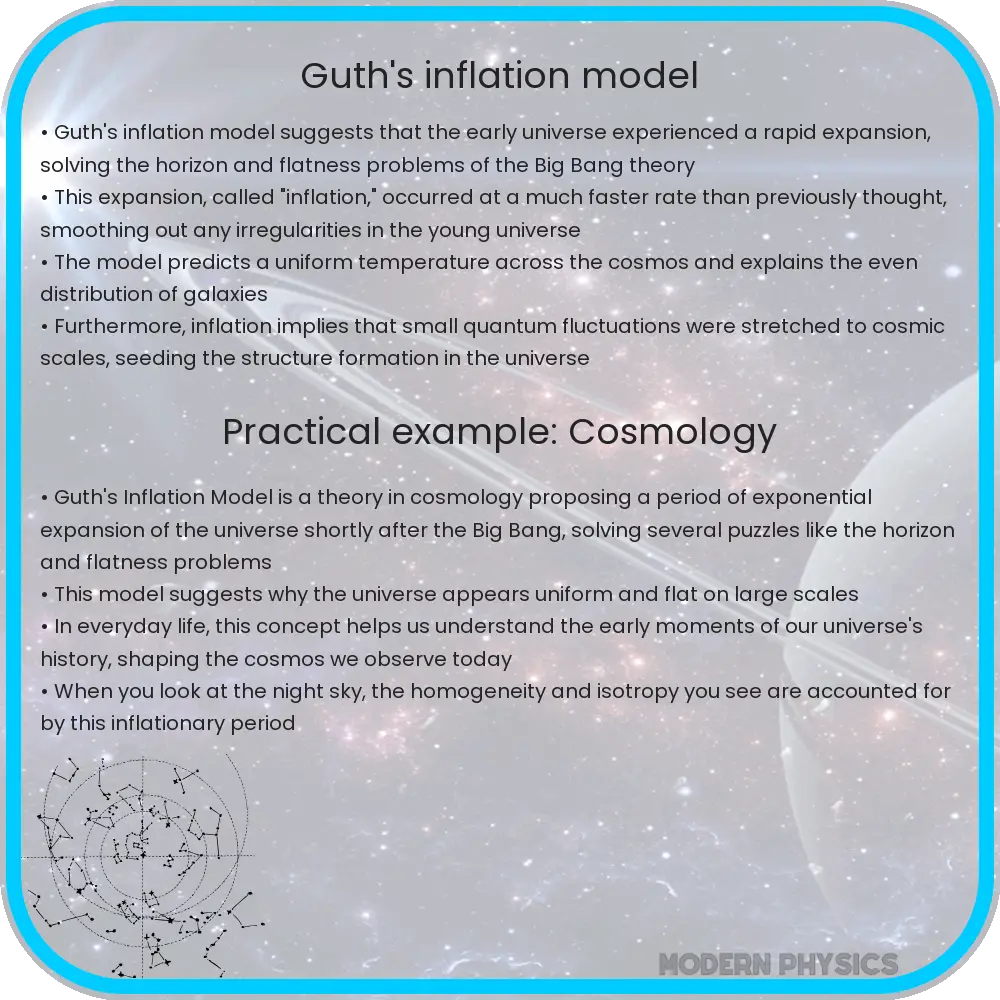Explore Guth’s inflationary model, the theory reshaping our understanding of the universe’s origin, rapid expansion, and structure, backed by cosmic microwave background evidence.

Introduction to Guth’s Inflationary Model
The concept of cosmic inflation, a theory first proposed by Alan Guth in 1980, has revolutionally reshaped our understanding of the early universe. This groundbreaking model provides explanations for several puzzling aspects of the universe’s origin, expansion, and overall dynamics. Guth’s inflationary model proposes that the universe underwent an exponential expansion in the first few fractions of a second after the Big Bang.
Origin and Early Development
The early 1980s were a period of significant advancement in cosmological theories, with Guth at the forefront, introducing the idea of inflation. Initially conceived to address the horizon and flatness problems of the Big Bang theory, inflation posits a period of rapid exponential expansion. This expansion was driven by a hypothetical form of energy called the inflaton field. According to the model, this field underwent a phase transition, similar to water freezing into ice, releasing vast amounts of energy and causing the universe to expand at an unprecedented rate.
Expansion and Universe Dynamics
One of the most compelling aspects of Guth’s inflation model is its explanation for the uniformity and structure of the cosmos. During inflation, quantum fluctuations in the inflaton field were stretched to macroscopic scales, seeding the formation of large-scale structure in the universe. These fluctuations are preserved in the cosmic microwave background radiation, serving as a snapshot of the early universe and providing strong evidence for inflation.
Furthermore, Guth’s model accounts for the universe’s flatness and homogeneity. Pre-inflation, the observable universe might have been tiny, and hence, any initial irregularities were ironed out during its exponential expansion. This process also explains why the observable universe appears flat, as any curvature would have been diluted during inflation.
The implications of Guth’s inflationary model are profound, extending beyond the dynamics of the universe’s expansion to encompass the origin of all cosmic structure. By providing a mechanism for the generation of primordial density fluctuations, Guth’s theory lays the foundation for understanding the distribution of galaxies and the large-scale structure of the universe.
Implications and Observational Evidence
The inflationary model proposed by Guth has not only theoretical implications but also observable consequences. One of the most significant pieces of evidence supporting inflation comes from the detailed observations of the cosmic microwave background (CMB) radiation. The CMB is the afterglow of the Big Bang, and its minute temperature fluctuations provide a fingerprint of the early universe. Observations made by satellites such as COBE, WMAP, and Planck have revealed patterns in the CMB that closely match the predictions made by inflationary models, such as the scale-invariant spectrum of density perturbations.
Another cornerstone of observational evidence is the large-scale structure of the universe. The distribution of galaxies and galaxy clusters across vast cosmic distances exhibits patterns that can be traced back to the initial quantum fluctuations magnified by cosmic inflation. These structures fit well with predictions derived from inflationary theory, offering a compelling case for its accuracy.
Challenges and Future Directions
Despite its successes, Guth’s inflationary model is not without its challenges. The nature of the inflaton field and the specifics of the inflationary process remain largely hypothetical, with various models proposing different scenarios for how inflation started and ended. Additionally, the energy scale of inflation and the exact properties of the inflaton remain areas of active research and debate.
Future observations and experiments, such as more precise measurements of the CMB polarization and large-scale structure surveys, are expected to provide further tests of inflationary models. These studies may help refine our understanding of the inflationary period and its role in the evolution of the cosmos.
Conclusion
Guth’s inflationary model represents a pivotal chapter in our understanding of the universe’s early moments. By proposing a mechanism that explains the uniformity and structure of the cosmos, it addresses fundamental questions that the traditional Big Bang model could not. While challenges remain, the inflationary model stands as a cornerstone of modern cosmology, supported by substantial observational evidence and continuing to inspire new theories and discoveries about the universe’s origin and its grand scale dynamics. As research progresses, Guth’s model will likely evolve, but its core principle of a rapid, exponential expansion in the universe’s infancy remains a critical element in our quest to understand the cosmos.
